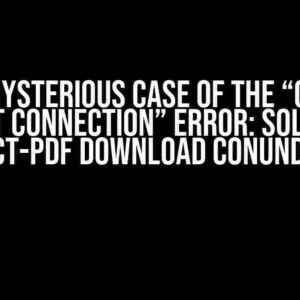Ah, the dreaded 404 File Not Found error on your Github page! Don’t worry, you’re not alone. It’s a common issue that can be frustrating, especially when you’re trying to showcase your project to the world. In this comprehensive guide, we’ll take you by the hand and walk you through the steps to troubleshoot and fix the 404 File Not Found error on your Github page. By the end of this article, you’ll be able to identify the root cause of the issue and resolve it like a pro!
Understanding the 404 File Not Found Error
Before we dive into the troubleshooting process, it’s essential to understand what the 404 File Not Found error means. A 404 error occurs when a web browser or client requests a resource (in this case, your Github page) that doesn’t exist on the server. In other words, the file or page you’re trying to access can’t be found.
Common Reasons for 404 File Not Found Error on Github Pages
There are several reasons why you might encounter a 404 File Not Found error on your Github page. Here are some common culprits:
Incorrect repository name or username: Double-check that your repository name and username are correct and match the URL you’re trying to access.Incorrect file name or path: Make sure the file name and path are correct, including capitalization and punctuation.Missing or incorrect index file: Ensure that you have an index file (e.g.,index.html) in the root directory of your repository.Broken links or redirects: Check for broken links or redirects that might be causing the error.Github Pages configuration issues: Review your Github Pages configuration to ensure it’s set up correctly.File permissions or access issues: Verify that the files have the correct permissions and access settings.
Troubleshooting the 404 File Not Found Error
Now that we’ve covered the common reasons for the 404 File Not Found error, let’s get started with the troubleshooting process. Follow these steps to identify and fix the issue:
Step 1: Check the Repository Name and Username
Make sure your repository name and username are correct and match the URL you’re trying to access. You can do this by:
1. Logging in to your Github account 2. Navigating to your repository 3. Checking the repository name and username in the URL
Step 2: Verify the File Name and Path
Ensure the file name and path are correct, including capitalization and punctuation. Check the following:
1. File name: Ensure the file name is correct, including any extensions (e.g., .html, .css, etc.) 2. File path: Verify the file path is correct, including any subdirectories 3. Capitalization: Check that the file name and path are correctly capitalized
Step 3: Check for an Index File
Make sure you have an index file (e.g., index.html) in the root directory of your repository. This file is the default file that Github Pages will serve when a user visits your page. If you don’t have an index file, create one or rename an existing file to index.html.
Step 4: Inspect Broken Links or Redirects
Check for broken links or redirects that might be causing the 404 error. You can do this by:
1. Inspecting the HTML code of your page 2. Using the browser's developer tools (e.g., Chrome DevTools) to inspect the requests and responses 3. Verifying that all links and redirects are correct and functional
Step 5: Review Github Pages Configuration
Review your Github Pages configuration to ensure it’s set up correctly. Check the following:
1. Repository settings: Verify that the repository is set to use Github Pages 2. Branch: Ensure the correct branch is selected (e.g.,masterorgh-pages) 3. Directory: Check that the directory is set to the root of your repository 4. Theme: Verify that the theme is correctly configured
Step 6: Check File Permissions and Access
Verify that the files have the correct permissions and access settings. You can do this by:
1. Checking the file permissions in your repository settings 2. Ensuring that the files are not protected by Github's file access restrictions
Resolving the 404 File Not Found Error
Once you’ve identified the root cause of the issue, it’s time to resolve it! Here are some common solutions:
Solution 1: Update the Repository Name or Username
If the issue is due to an incorrect repository name or username, update the URL to reflect the correct information.
Solution 2: Correct the File Name or Path
If the issue is due to an incorrect file name or path, update the file name or path to reflect the correct information.
Solution 3: Add an Index File
If the issue is due to a missing index file, create an index.html file in the root directory of your repository.
Solution 4: Fix Broken Links or Redirects
If the issue is due to broken links or redirects, update the links or redirects to reflect the correct information.
Solution 5: Update Github Pages Configuration
If the issue is due to incorrect Github Pages configuration, update the configuration to reflect the correct information.
Solution 6: Update File Permissions or Access
If the issue is due to incorrect file permissions or access, update the file permissions or access settings to reflect the correct information.
Conclusion
And there you have it! With these steps and solutions, you should be able to identify and fix the 404 File Not Found error on your Github page. Remember to stay calm, be patient, and methodically work through the troubleshooting process. If you’re still stuck, don’t hesitate to reach out to the Github community or seek further guidance. Happy coding!
| Common 404 File Not Found Error Causes | Solutions |
|---|---|
| Incorrect repository name or username | Update the repository name or username |
| Incorrect file name or path | Correct the file name or path |
| Missing or incorrect index file | Add an index file (e.g., index.html) |
| Broken links or redirects | Fix broken links or redirects |
| Github Pages configuration issues | Update Github Pages configuration |
| File permissions or access issues | Update file permissions or access settings |
By following this guide, you’ll be well on your way to resolving the 404 File Not Found error and getting your Github page up and running smoothly. Happy troubleshooting!Here are 5 Questions and Answers about “Github page: 404 File not found” in a creative voice and tone:
Frequently Asked Question
Getting the dreaded “404 File not found” error on your GitHub page? Don’t panic! We’ve got you covered. Check out these FAQs to get your page up and running in no time.
Why am I seeing a 404 File not found error on my GitHub page?
This error usually occurs when your GitHub page can’t find the file it’s looking for. It might be due to a typo in your repository name, a missing file, or an incorrect file path. Double-check your repository settings and file structure to ensure everything is in order!
How do I troubleshoot the 404 File not found error on my GitHub page?
First, check your repository settings to ensure that your GitHub page is correctly configured. Then, verify that your file exists and is in the correct location. If you’re still stuck, try checking the file’s case sensitivity and ensure that your file path is correct. If all else fails, try resetting your GitHub page or seeking help from GitHub support.
What are some common reasons for the 404 File not found error on GitHub pages?
Typical culprits include typos in the repository name or file path, incorrect file naming conventions, and missing or deleted files. Additionally, incorrect Jekyll configuration or plugin issues can also cause this error. Make sure to review your repository settings and file structure to identify the root cause of the issue.
How do I fix the 404 File not found error if I’ve cloned my repository from someone else?
If you’ve cloned a repository from someone else, ensure that the original repository has the correct file structure and naming conventions. Then, check your cloned repository for any discrepancies. If you’re still getting the error, try resetting your GitHub page or seeking help from the original repository owner.
What if none of the above solutions work for my GitHub page?
Don’t worry! If you’ve tried all the above solutions and still can’t resolve the issue, it’s time to reach out to GitHub support. They’ll be able to provide more personalized assistance and help you get your GitHub page up and running in no time.








